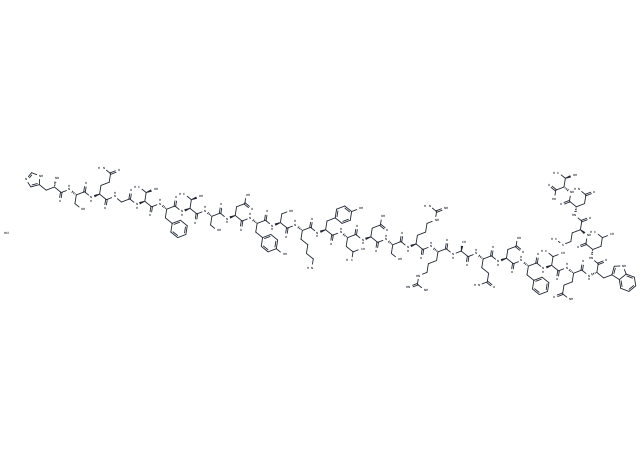Shopping Cart
- Remove All
 Your shopping cart is currently empty
Your shopping cart is currently empty

Glucagon (1-29), bovine, human, porcine hydrochloride (Porcine glucagon hydrochloride) is a peptide hormone produced by pancreatic α-cells that activates HNF4α, increases HNF4α phosphorylation, and stimulates gluconeogenesis.

| Pack Size | Price | Availability | Quantity |
|---|---|---|---|
| 1 mg | $79 | In Stock | |
| 5 mg | $193 | In Stock | |
| 10 mg | $289 | In Stock | |
| 25 mg | $498 | In Stock | |
| 50 mg | $729 | In Stock | |
| 100 mg | $985 | In Stock | |
| 500 mg | $1,970 | In Stock |
| Description | Glucagon (1-29), bovine, human, porcine hydrochloride (Porcine glucagon hydrochloride) is a peptide hormone produced by pancreatic α-cells that activates HNF4α, increases HNF4α phosphorylation, and stimulates gluconeogenesis. |
| In vitro | Glucagon stimulates both hepatic kisspeptin1 production and gluconeogenesis. Upon binding to its receptor Gcgr, Glucagon activates cAMP-PKA signaling to stimulate hepatic glucose production (HGP) and cause hyperglycemia. Glucagon (100 nM) increases the phosphorylation of HNF4α. Glucagon (100 nM) represses CYP7A1 mRNA expression in human primary hepatocytes [3]. |
| In vivo | Glucagon (20 μg/kg) increases glycemia and does not stimulate insulin secretion in ambient-fed mice. High-dose (1 mg/kg) Glucagon lowers glycemia compared with PBS control and stimulates insulin secretion in ambient-fed mice [4]. |
| Alias | Glucagon hydrochloride |
| Molecular Weight | 3519.21 |
| Formula | C153H225N43O49S.ClH |
| Cas No. | 28270-04-4 |
| Smiles | Cl.CSCC[C@H](NC(=O)[C@H](CC(C)C)NC(=O)[C@H](Cc1c[nH]c2ccccc12)NC(=O)[C@H](CCC(N)=O)NC(=O)[C@@H](NC(=O)[C@H](Cc1ccccc1)NC(=O)[C@H](CC(O)=O)NC(=O)[C@H](CCC(N)=O)NC(=O)[C@H](C)NC(=O)[C@H](CCCNC(N)=N)NC(=O)[C@H](CCCNC(N)=N)NC(=O)[C@H](CO)NC(=O)[C@H](CC(O)=O)NC(=O)[C@H](CC(C)C)NC(=O)[C@H](Cc1ccc(O)cc1)NC(=O)[C@H](CCCCN)NC(=O)[C@H](CO)NC(=O)[C@H](Cc1ccc(O)cc1)NC(=O)[C@H](CC(O)=O)NC(=O)[C@H](CO)NC(=O)[C@@H](NC(=O)[C@H](Cc1ccccc1)NC(=O)[C@@H](NC(=O)CNC(=O)[C@H](CCC(N)=O)NC(=O)[C@H](CO)NC(=O)[C@@H](N)Cc1cnc[nH]1)[C@@H](C)O)[C@@H](C)O)C(C)C)C(=O)N[C@@H](CC(N)=O)C(=O)N[C@@H]([C@@H](C)O)C(O)=O |
| Relative Density. | no data available |
| Storage | store at low temperature,keep away from moisture | Powder: -20°C for 3 years | In solvent: -80°C for 1 year | Shipping with blue ice. | ||||||||||||||||||||
| Solubility Information | DMSO: 10 mM, Sonication is recommended. H2O: 40 mg/mL (11.37 mM), when pH is adjusted with HCl, sonication is recommended. | ||||||||||||||||||||
Solution Preparation Table | |||||||||||||||||||||
DMSO/H2O
| |||||||||||||||||||||

Copyright © 2015-2025 TargetMol Chemicals Inc. All Rights Reserved.